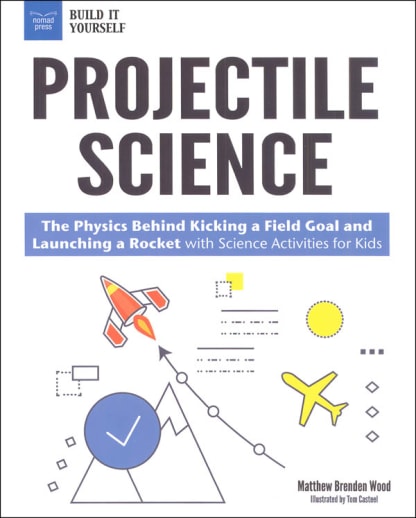Physics may be the most applicable to everyday life of any of the science branches. But sometimes, in the throes of memorizing definitions and laws, we lose sight of the practical application. It is time to breathe fresh excitement for real life science into your day! Beginning with an overview of projectiles timeline and science, each chapter targets one concept from the laws of motion, trajectories, mechanical energy, air resistance, and rockets. Along the way children will learn the laws of motion, practice math, make slingshots and a trebuchet; throw whiffle balls and launch a rocket (additional cost). Activities primarily require easily found materials. Includes QR codes and URL links for primary sources. Take physics learning to the next level with this appealing hands-on book! Softbound. ~Deanne
Projectile Science: Physics Behind Kicking a Field Goal and Launching a Rocket with Science Activities for Kids
Description
In Projectile Science: The Physics Behind Kicking a Field Goal and Launching a Rocket with Science Activities for Kids, one of four titles in the Technology for Today set, kids ages 10 to 15 learn why projectiles follow the paths they do and what factors influence those paths. Readers who are fascinated with potato cannons, slingshots, and rocketry will love taking that next step and applying what they learn about the laws of physics to the science of figuring out where to aim.
Math is the language you use to understand the science of ballistics. In this book, readers will learn about the forces that act on the projectiles and how to calculate those forces to make educated predictions about where their homemade rockets and other projectiles will land. 25 Safe, hands-on STEAM activities using materials that are easy to acquire are a terrific way to foster real-life learning about ballistics. Kids will perform Galileo's famous test for gravity, create clinometers to measure height and distance, and build a machine that can throw curve balls.
Essential questions that promote critical examination of the science, primary sources, online videos, and science-minded engineering activities let readers have a blast learning about the physics of ballistics!
| Product Format: | Paperback |
|---|---|
| Grades: | 5-10 |
| Brand: | Nomad Press |
| ISBN: | 9781619306783 |
| Length in Inches: | 10 |
| Width in Inches: | 8 |
| Height in Inches: | 0.375 |
| Weight in Pounds: | 0.7 |

